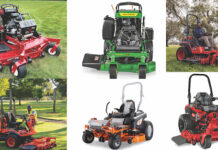Contributed by Husqvarna
Cutting down a tree, also known as felling a tree, requires planning, skill, and a healthy amount of respect for your tools and the tree. Depending on the surroundings, environment, and size of the tree, it can be a potentially dangerous job that is best left to trained arborists. However, if the tree is a manageable size, a well-prepared person with the right tools can fell a tree safely and efficiently.

When planning to fell any tree, some basic elements should always be followed:
- Be Well-Equipped – If you haven’t already done so, get adequate training for chainsaw usage. Make sure your saw is in optimal working order, with fuel, bar oil and a sharp chain, properly adjusted. Invest in personal protective equipment (PPE), including helmet, ear and eye protection, gloves, proper boots, and chainsaw-resistant chaps. Always wear PPE when operating a chainsaw.
- Assess The Tree – Understand the height and diameter of the tree as well as the lean, which may require different cutting techniques (more below). Understand the dynamics of tree-felling, especially what could go wrong.
- Examine Your Surroundings – It’s important to look all around, considering obstacles the tree could contact during the fall, the wind conditions during the job, as well as the slope of the ground you are working from. You need to plan where the tree will fall and plan your own safe escape route.
- A Good Start – A chainsaw is best started on the ground, with the chain brake engaged. Making the right cuts from the start will result in a good, clean hinge and a job that goes according to plan.
- Removing the Tree – Felling may be the most dynamic and invigorating part of the job, but the work to remove the debris requires its own skills and presents different challenges.
Once on-site with ready equipment, walk around the tree and, as said, assess the lean and determine where you want it to fall. It’s important to observe from multiple angles. Trees that appear to be perfectly straight from one angle may, in fact, have pronounced leans. A leaning tree acts differently from a straight tree as you cut and as it falls.
It’s your job to make cuts that manage the hinge-point you’re creating, so it supports the tree until you’re ready for it to fall. A tall tree carries a lot of weight high off the ground. If your hinge is too weak and allows the tree to begin to lean before you’re ready, pressure can build above the hinge and the trunk can snap resulting in a dangerous and uncontrolled event. It’s critical your hinge maintains its integrity and bears the weight of the tree until you make the final cut.
Once you determine where the tree will fall, plan an escape route so you can get a safe distance away. Stay far away from the stump since during the fall, the tree may “kick back” violently at the stump. Clean up the escape route as needed before felling to ensure the area is free of debris and hazards.
Making The Cut
There are several types of cuts you can make depending on the tree. The first cut to make is the notch cut on the face of the tree on the side where it will fall. There are three basic notch cuts:
- A “Standard” 45˚cut, with the bottom level.
- A “Humboldt,” which is an upside-down standard notch. In this case, the wedge created will slide out and the remaining stump will be angled. This notch is often used to harvest hardwoods for milling lumber.
- An “Open Face” which is an approximately 70˚ angle standard cut that is about 80% across the face of the tree. When this notch is made, imagine the tree “closing” the notch completely when it falls. Skilled arborists in need of felling accuracy and efficiency often use this notch.
Next, a bore cut is made about a 1.5” behind the bottom of the notch. This cut sets up the hinge. It’s important the bore cut does not break the hinge by cutting through to the notch at any point. When making a bore cut, keep in mind the dynamics of the saw. Begin a bore cut by contacting the tree at the lower tip of the chain. Using the top of the chain will cause the saw to kick back toward you. We call the bar top the “no-go-zone.”
You can bore completely through the tree. When through, set the chain brake and remove the saw from the cut. Pull the saw out of the bore while the chain is stopped to prevent cutting through the hinge, which could create a dangerously unstable tree.
Next, re-insert the saw and cut toward the backside. Cut about 80% through, leaving a section of “holding wood” to keep the tree stable. It’s advisable to insert a wedge into the backside cut as soon as possible to prevent the tree from leaning away from the hinge and potentially binding the saw.
Now the tree is ready to fall. Re-examine the surroundings, the fall zone, and escape route. Make the final cut through the holding wood on the tree back. Once the back cut is made and the tree begins to fall, move away.
Occasionally, after making the final cut, wedges may also be required to help the fall. This is common with trees leaning opposite the desired felling direction. If the tree doesn’t begin to fall after the back cut, strike the wedge already in position with the axe butt until the tree kerf (the groove created by cutting) begins to open. Watch the kerf closely and evacuate as it opens.
Limb & Buck
Once the tree falls, it’s time to “limb and buck” for removal. A tree resting its branches on the ground is still a hazard. Use care in relieving the pressure on branches to prevent the saw from binding and to ensure the tree doesn’t roll uncontrollably. Keep the work zone clean as you remove branches to reduce trip hazards.
Felling a tree is a physical exercise. When fatigue sets in, accidents are more likely. So be aware of fatigue, stay hydrated, and be prepared to come back fresh and rested the next day.
Visit Husqvarna.com for more chainsaw and tree felling information and instruction. A number of videos and content are available. Husqvarna dealers are a great resource to assist with proper equipment use, or to recommend a tree professional if required.
Do you have a comment? Share your thoughts in the Comments section below, or send an e-mail to the Editor at acosgrove@groupc.com.











![[VIDEO] Dickies®: Discover Workwear That’s Anything But Uniform](https://turfmagazine.com/wp-content/uploads/2023/06/1647663814-4b1a2a7742790a9b1e97a3b963477850192e1d6a9dfba9b07214a77bae25d6e3-d-218x150.jpg)






























![[VIDEO] Dickies®: Discover Workwear That’s Anything But Uniform](https://turfmagazine.com/wp-content/uploads/2023/06/1647663814-4b1a2a7742790a9b1e97a3b963477850192e1d6a9dfba9b07214a77bae25d6e3-d-324x160.jpg)